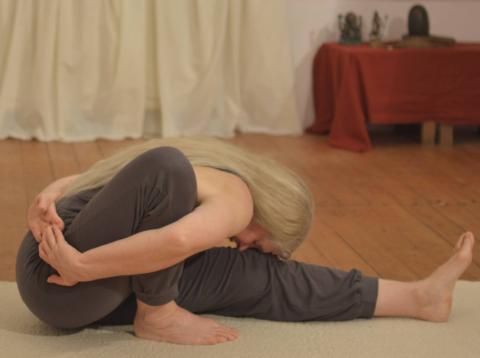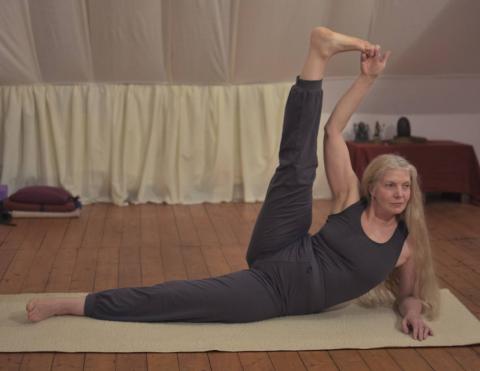Asanam iti sva svarUpe samAsannata svastikAsanam padmAsanama siddhAsanam etesAm madhye yathestam ekam vidhAya sAvadhAnena sthAtavyam
Asana means to rest in one's original state. After taking up one of the postures like Svastikasana, Padmasana, Siddhasana one should keep them attentively.
2.34 Siddha siddhAnta paddhatiH
of GorakshanAtha
Asana, the Body Posture
Asana means „seat“. Asanas are body postures that are held over a prolonged period of time with breath control and attentive mind. Asana is the first limb of the path of yoga, it is concerned with becoming conscious of the physical body-it's harmonising and mastery.
A student of yoga will learn postures and reverse postures to create a smooth and powerful body. Asanas are assumend and held after the body is prepared by warming up exercises. An asana is never forced.
Contrary to sports muscular power is used as sparsingly as possible. An optimal shifting of the centre of gravity leads to balance, any muscles that are not needed to support the posture are consciously relaxed. An asana should be kept and held for the duration of at least six deep full breaths. One can rest in it as long as one´s strength allows.

In the more unusual postures like reverse forward, side and back bends and by stretching and elongation, the flow of blood, breath and lymphatic fluid is directed purposefully.
The body is stressed in a healthy way. The flow of blood is constrained and the muscles are elongated beyond their usual measure. When the body returns into its original state the targeted body part is sucking up fresh blood like a sponge. The cells regenerate.
The body needs time to adapt to the unusual challenge. It is important to relax for a while after the asana attentively, until the system has settled down. Attention should be turned inwards, to be able to notice changes in body warmth and activation, increased circulation and so on.
The muscular elongation allows the joints to become fully activated because their function is not restricted any more.Because every muscular elongation causes reverse tension, it is necessary to to always add a reverse elongation.
There is no rocking, pushing, pulling in Yoga. This would only cause a behaviourally protective reaction. The aim of Asana practice is to reach a balance between strength and tightness (sthira) and a relaxed pleasurable state of flexibility (sukha).
During asana a dialogue with the body ensues. Inward turned awareness is more important than correct outward performance.
Bearable discomfort should be tolerated until yoga becomes a pleasant experience. The beneficial bodily results happen inspite of minor discomforts.
It is important to become aware of the body and accept it as it is, this enables us to find out the best individual way to practice and work with it. We have to take the time to deal attentively with ourself. It is challenging to enquire into our own possibilities and limitations to be able to release blockades and armorings. It is of crucial importance to never go beyond the pain threshold. The only achievement would be a muscle strain.
The middle-aged or old person beginning to learn yoga cannot expect to achieve the flexibility and smoothness of someone who already began to learn the practice of asana in his early childhood.
Experience teaches that though the beginning is hard, after some time of practice the body can obtain flexibility much more easily and faster.
Yoga should not be competitive, neither concerning comparison with others abilities, nor with one's own progress. To simply let things happen and the sacrifice of endeavour is at first a challenging task.
The restless mind and the clumsy body can only be coordinated by concentration on the breath. Part of every asana is a conscious entering into it and exiting it, this is possible by correct breathing. As a rule exhaling is done while entering into a posture and the power of the inbreath is supporting the exiting. Every movement follows the breath.

Breathing is done solely through the nose, that way the dry air is filtered, purified and warmed up during the inbreath. The warm air coming from the lungs during the outbreath moistens the nasal muccous membranes, which creates healthy conditions for the next inbreath. Every outbreath helps releasing and relaxing, the inbreath strengthens and stabilises the body in the held position.
The breath should flow slowly, smooth, deep and without any exertion. This way it will help to keep the concentration and ease the attentive holding of the postures.
The lack of motion during the asana is does not mean lack of activity. After one has assumend the desired posture, self reflection is taken up, assisted by the smooth flow of breathing. One should not allow the breath to flow irregularly.
It is important to exit an asana in a controlled way, before it becomes displeasurable, cramps set in, or
one´s strengths becomes insufficient. Due to the interaction of the breath mind and body a mere posture transforms into an asana.
Besides the mere bodily posture an asana is accompanied by control of the breath and by patient extinction of outward interferences due to sense impressions. (Pratyahara)
But neither concentration on the breath nor inward turned attention can be enforced. They have to develop by constant practice on their own.
By recurring patterns of activity the mind becomes inattentive. Daily routine develops. Due to the unusual movement patterns during the practice of yoga attentiveness is trained. This leads to an awareness which is useful in daily life. Because of daily routine most people develop one-sided. In a right-handed person the right body part is developed much stronger. The yoga practice aims to counter one-sided developments. Body and mind return to balance.
There is not a perfectly performed asana. Even after practising yoga body postures for many years, a simple posture will lead to new experiences and challenges. Exploring a posture deeper and deeper one will develop more subtle awareness. Constantly new pathways open up and with wonder and astonishment one realises the vastness and wisdom of the path of a Yogi. The bodily strength and flexibility achieved by the practice of asana enables a yogi to sit for a prolonged time in an erect posture, uninterrupted by bodily discomfort and able to practice the mental exercises of Yoga.
